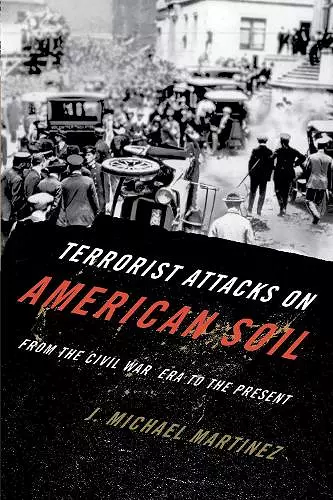Terrorist Attacks on American Soil
From the Civil War Era to the Present
Format:Paperback
Publisher:Rowman & Littlefield
Published:28th Dec '17
Currently unavailable, and unfortunately no date known when it will be back

Understanding the context of terrorism requires a trek through history, in this case the history of terrorist activity in the United States since the Civil War. Because the topic is large and complex, Terrorists Attacks on American Soil: From the Civil War to the Present does not claim to be an exhaustive history of terrorism or the definitive account of how and why terrorists do what they do. Instead, this book takes a representative sampling of the most horrific terrorist attacks on U.S. soil in an effort to understand the context in which they occurred and the lessons that can be learned from these events.
The United States has suffered a number of violent attacks on its own soil. Martinez (Coming for To Carry Me Home) surveys 12 of them: three in the 19th century (e.g., the 1857 Mountain Meadows Massacre); five in the 'Modern Era' (e.g., the Ku Klux Klan’s 16th Street Baptist Church bombing of 1963); and four examples of 'Postmodern Terror' (e.g., the Oklahoma City bombing and 9/11). He examines each attack to determine whether it qualifies as a 'terrorist act.' . . . He covers the social circumstances surrounding each attack in order to describe the motivations and origins of the perpetrators. In the cases of individual actors such as Ted Kazinsky, the Unibomber, this is effective. . . . Martinez’s conclusion . . . is that throughout history disaffected people have resorted to terrorism to spread or emphasize their causes. * Library Journal *
Martinez (Kennesaw State Univ.) has produced a pithy, highly readable analysis of selected terrorist attacks in the US since the Civil War era. The author notes that he does not intend his book to be an exhaustive history of terrorism, but rather a representative sampling of some of the major incidents of the last 150 years. His stated purpose is to examine some of the common characteristics found in these past terrorist attacks in order not only to better understand them, but also to draw useful lessons for modern students of terrorism. Each chapter examines a particular incident and then provides some analysis as to whether or not the incident even qualifies as terrorism, based on selected criteria. While Martinez acknowledges that there is no magic formula to identify terrorism, he does provide a very useful conceptual framework for studying the phenomenon and its impact on US history. Summing Up: Recommended. General readers, lower-division undergraduates, upper-division undergraduates. * CHOICE *
In this work, Martinez, an attorney with a string of books to his credit that touch upon law, rights, and history, reminds us that terrorism is not unknown in American history, though until recently we have usually been quick to put it behind us. In a dozen chapters he examines notable cases of terrorist incidents outbreaks in America, most of which were well known in their day, yet are largely forgotten today: the Mountain Meadows Massacre (1857), the Confederate Yellow Fever plot (1864-1865), the Colfax Massacre (1873) , the Los Angeles Times bombing (1910), the Wall Street 'Wagon Bomb' (1920), the Truman assassination attempt (1950), the 16th Street Baptist Church bombing (1963), the 'Weather' underground (1960s), the 'Unabomber' (1970s-1990s), Oklahoma City (1995), the Atlanta Olympics Bombing (1996), and 9/11. Martinez opens each chapter with the circumstances that led to the incident. He then looks at the perpetrators, religious or political 'true believers,' disaffected loners, white racists, or radical nationalists, trying to understand what they saw as their objectives and their choice of tactics. He then gives us a concise account of the incident as it unfolded, the official response, the consequences of the event, and any lessons to be learned. While Martinez hardly covers more than a handful of terror attacks on American soil, his examples . . . cover the varying nature of these events and the people who committed them, making this a profitable read for the concerned citizen. * The NYMAS Review *
ISBN: 9780810896208
Dimensions: 219mm x 148mm x 34mm
Weight: 685g
488 pages